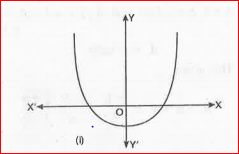Which of the following arguments are correct ? Give reasons for your answer : If two coins are tossed simultaneously there are three possible outcomes - two heads, two tails or one of each. Therefore, for each of these outcomes, the probability is .Solution in Punjabi
Step by step video & image solution for Which of the following arguments are correct ? Give reasons for your answer : If two coins are tossed simultaneously there are three possible outcomes - two heads, two tails or one of each. Therefore, for each of these outcomes, the probability is 1/3. by Maths experts to help you in doubts & scoring excellent marks in Class 10 exams.
Updated on:21/07/2023Topper's Solved these Questions
Similar Questions
If a die is thrown, what is the probability that an 'ace' turns up ?
View SolutionThe graphs of y = p (x) are given in figure below, for some polynomials p (x). Find the number of zeroes of p (x), in each case.
 .
.
View SolutionCheck whether the following is quadratic equation :- x=174−1x .
View SolutionWhich of the following arguments are correct and which are not correct? Give reasons for your answer.(i) If two coins are tossed simultaneously there are three possible outcomes two heads, two tails or one of each. Therefore, for each of these outcomes the probability is 1/3(ii)if a die is thrown, there are two possible outcomes, an odd no. or an even no. Therefore ,the probability of getting an odd no. is 1/2.
View SolutionThree coins are tossed simultaneously 200 times with the following frequencies of different outcomes: Outcome: 3 heads 2 heads 1 head No head Frequency: 23 72 77 28 Find the probability of getting: (i) three heads (ii) two heads and one tail (iii) at least two heads
View SolutionExamine, If two coins are tossed at the same time, there are 3 possible outcomes two heads, two tails, or one of each. Therefore, for each outcome, the probability of occurrence is 1/3 .
View SolutionThree coins are tossed simultaneously 200 times with the following frequencies of different outcomes: Outcome: 3 heads 2 heads 1 head No head Frequency: 23 72 77 28 Find the probability of getting: (i) three heads (ii) two heads and one tail (iii) at least two heads
View SolutionTwo coins are tossed simultaneously 500 times with the following frequencies of different outcomes: Two heads: 95 times One tail : 290 times No head: 115 times Find the probability of occurrence of each of these events.
View SolutionWhen we toss a coin, there are two possible outcomes-heat or tail. Therefore, the probability of each outcome is 12. Justify your answer.
View Solutionनीचे लिखे तर्क सत्य है अथवा असत्य ? सकारण उत्तर दीजिए -
यदि दो सिक्कों को एक साथ उछाला जाता है, तो इसके तीन संभावित परिणाम - दो चित्त, दो पट या प्रत्येक एक बार है। अतः इनमें से प्रत्येक की प्रायिकता 13 है।
View SolutionWhich of the following arguments are correct and which are not correct? Give reasons for your answer.
If two coins are tossed simultaneously there are three possible outcomes - two heads, two tails or one of each. Therefore, for each of these outcomes, the probability is 13
View SolutionWhich of the following arguments are correct and which are not correct? Give reasons.
i) If two coins are tossed simultaneously there are three possible outcomes - two heads, two tails or one of each. Therefore, for each of these outcomes, the probability is 13
ii)If a die is thrown, there are two possible outcomes - an odd number or an even number. Therefore, the probability of getting an odd number is 12
View SolutionWhich of the following arguments are correct and which are not correct? Give reasons.
i) If two coins are tossed simultaneously there are three possible outcomes - two heads, two tails or one of each. Therefore, for each of these outcomes, the probability is 13
ii)If a die is thrown, there are two possible outcomes - an odd number or an even number. Therefore, the probability of getting an odd number is 12
View SolutionWhich of the following arguments are correct and which are not correct? Give reasons for your answer.(i) If two coins are tossed simultaneously there are three possible outcomes two heads, two tails or one of each. Therefore, for each of these outcomes the probability is 1/3(ii)if a die is thrown, there are two possible outcomes, an odd no. or an even no. Therefore ,the probability of getting an odd no. is 1/2.
View SolutionWhen we toss a coin, there are two possible outcomes-head or tail. Therefore, the probability of each outcome is 12. Justify your answer.
View SolutionThree coins are tossed simultaneously 200 times with the following frequencies of different outcomes: Outcome: 3 heads 2 heads 1 head No head Frequency: 23 72 77 28 Find the probability of getting: (i) three heads (ii) two heads and one tail (iii) at least two heads
View Solution

